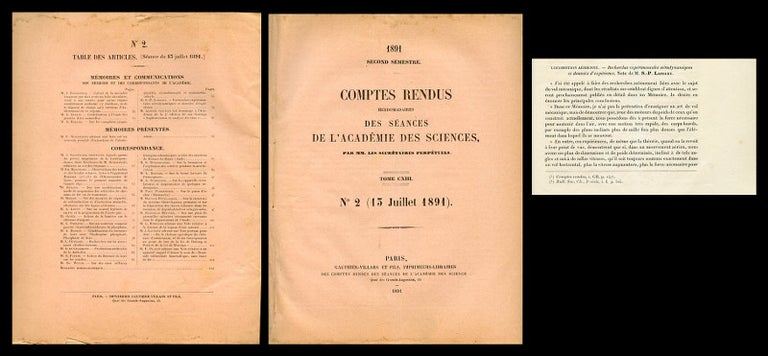Recherches Expérimentales Aérodynamiques et Donnés D’Expérience in Comptes Rendus, Tome CXIII (113), No. 2, 13 Juillet 1891, pp. 59-63
Paris: Gauthier-Villars, 1891. 1st Edition. FIRST EDITION IN ORIGINAL WRAPS OF A VERY EARLY PAPER ON AERONAUTICS. “As a result of his observations, Mr. Langley announced in 1891 that it was possible to construct machines which would give such a velocity to inclined surfaces that bodies indefinitely heavier than the air could be sustained upon it and moved through it with great velocity” (National Academy of Biographical Memoirs, Vol. VII, 252).
Samuel Pierpont Langley was an astronomer and aeronautical pioneer known for his curious and expansive mind. In 1887 and while working at Pennsylvania's Allegheny Observatory, he built a large whirling table and began a series of experiments on ‘aerodynamics’. By later that same year, Langley was Assistant Secretary of the Smithsonian. Working with assistants at the institution, “in 1889 he tested stuffed birds on the whirling table; a frigate bird, a California condor and an albatross, with the result that none of them would lift as a live bird ought” (Gray, Flying Machines Portal).
“Langley and his assistants eventually built and tested over 100 of the model "aerodromes" and managed to secure flights of from 6 to 8 seconds and distances of between 80 and 100 feet. On the death of the head of the Smithsonian in November of 1887, Langley assumed the top post of Secretary. In 1889 he tested stuffed birds on the whirling table; a frigate bird, a California condor and an albatross, with the result that none of them would lift as a live bird ought” (ibid).
By 1891, Langley had moved on to experimenting with steam-engine powered Aerodromes, and was successful in powering one of them first by a carbonic gas and later by compressed air. He was the first to build a heavier-than-air flying machine--a steam powered model aircraft.
On the result of this work, Langley announced in 1891 that “Mechanical Flight is possible with engines we now possess,” on the basis of his prediction that a twenty-pound, one-horsepower steam engine could sustain the flight of a 200–pound airplane at a speed of forty-five miles per hour” (Dictionary of Scientific Biography, Vol. 8, p. 20). “This work lead to the human-carrying machine of 1903” (ibid).
Many French scientists were studying flight and Langley had queried them extensively; as those scientists published in Comptes Rendus, when Langley completed his 1891 paper, he too published there. Langley also published many of his other papers in Comptes. “It has been said that the work of the scientifically respected Langley brought experiments on flight out of the stage of ridicule and into a stage of science” (ibid). Item #690
CONDITION & DETAILS: Paris: Gauthier-Villars. Complete issue in original paper wraps. 4to (11.25 x 9 inches; 281 x 225mm). The wraps are very tightly attached. Minor scuffing and spotting at the edges, otherwise clean and bright throughout.
Price: $275.00

